Experimental Study on Diesel Engine Emission Characteristics Based on Different Exhaust Pipe Coating Schemes
Abstract
:1. Introduction
2. Methodology
2.1. Test Materials
2.2. Test Device and Data Processing
2.3. Test Conditions and Plan
3. Results and Discussion
3.1. Exhaust Temperature Analysis of the Full Cycle
3.2. Emission Analysis of the Full Cycle
3.3. Exhaust Temperature Analysis during Cold Operation
3.4. Analysis of the Emission Results during Cold Operation
4. Conclusions
Author Contributions
Funding
Data Availability Statement
Conflicts of Interest
References
- Yao, H.; Ni, T.; You, Z. Characterizing pollutant loading from point sources to the Tongqi River of China based on water quality modeling. Int. J. Environ. Sci. Technol. 2019, 16, 6599–6608. [Google Scholar] [CrossRef]
- Tangestani, V.; Isfahani, A.H.M. Experimental evaluation of the performance and exhaust emissions of porous medium diesel and Otto engines. Int. J. Environ. Sci. Technol. 2020, 17, 1463–1474. [Google Scholar] [CrossRef]
- Resitoglu, I.A.; Altınısık, K.; Keskin, A. The pollutant emissions from diesel engine vehicles and exhaust after treatment systems. Clean Technol. Environ. Policy 2015, 17, 15–27. [Google Scholar] [CrossRef] [Green Version]
- Prasad, R.; Bella, V.R. A review on diesel soot emission, its effect and control. Bull. Chem. React. Eng. Catal. 2010, 5, 69–86. [Google Scholar] [CrossRef]
- Zhang, Y.H.; Lou, D.M.; Tan, P.Q.; Hu, Z. Experimental study on the particulate matter and nitrogenous compounds from diesel engine retrofitted with DOC+CDPF+SCR. Atmos. Environ. 2018, 177, 45–53. [Google Scholar] [CrossRef]
- Resitoglu, I.A.; Keskin, A.; Özarslan, H.; Bulut, H. Selective catalytic reduction of NOx emissions by hydrocarbons over Ag–Pt/Al2O3 catalyst in diesel engine. Int. J. Environ. Sci. Technol. 2019, 16, 6959–6966. [Google Scholar] [CrossRef]
- Kang, W.; Choi, B.; Jung, S.; Park, S. PM and NOx reduction characteristics of LNT/DPF + SCR/DPF hybrid system. Energy 2018, 143, 439–447. [Google Scholar] [CrossRef]
- Zhang, Y.H.; Lou, D.M.; Tan, P.Q.; Hu, Z. Experimental study on the emission characteristics of a non-road diesel engine equipped with different after-treatment devices. Environ. Sci. Pollut. Res. 2019, 26, 26617–26627. [Google Scholar] [CrossRef]
- Yuan, X.M.; Liu, H.Q.; Gao, Y. Diesel Engine SCR Control: Current Development and Future Challenges. Emiss. Control. Sci. Technol. 2015, 1, 121–133. [Google Scholar] [CrossRef]
- Koebel, M.; Elsener, M.; Kleemann, M. Urea-SCR: A promising technique to reduce NOx emissions from automotive engines. Catal. Today 2000, 59, 335–345. [Google Scholar] [CrossRef]
- Sharariar, G.M.H.; Lim, O.T. Investigation of urea aqueous solution injection, droplet breakup and urea decomposition of selective catalytic reduction systems. J. Mech. Sci. Technol. 2018, 32, 3473–3481. [Google Scholar] [CrossRef]
- Kogan, F.M.; Nikitina, O.V. Solubility of chrysotile asbestos and basalt fibers in relation to their fibrogenic and carcinogenic action. Environ. Health Perspect. 1994, 102, 205–206. [Google Scholar]
- Mcconnell, E.E.; Kamstrup, O.; Musselman, R.; Hesterberg, T.W.; Hesterberg, T.W.; Chevalier, J.; Miiller, W.C.; Thevenaz, P. Chronic inhalation study of size-separated rock and slag wool insulation fibers in Fischer 344/N rats. Inhal. Toxicol. 1994, 6, 571–614. [Google Scholar] [CrossRef]
- Chen, J.; Gu, T.Z.; Yang, Z.J.; Min, L.I.; Wang, S.K.; Zhang, Z.G. Effects of Elevated Temperature Treatment on Compositions and Tensile Properties of Several Kinds of Basalt Fibers. J. Mater. Eng. 2017, 45, 61–66. [Google Scholar]
- Fiore, V.; Scalici, T.; Di, B.G.; Valenza, A. A review on basalt fibre and its composites. Compos. Part B 2015, 74, 74–94. [Google Scholar] [CrossRef]
- Yan, L.; Chu, F.L.; Tuo, W.Y.; Zhao, X.; Wang, Y.; Zhang, P.; Gao, Y. Review of research on basalt fibers and basalt fiber-reinforced composites in China (I): Physicochemical and mechanical properties. Polym. Polym. Compos. 2020. [Google Scholar] [CrossRef]
- Militky, J.; Kovaeie, V.; Rubnerova, J. Properties and applications of basalt fibres. Text. Asia 2001, 32, 29–33. [Google Scholar]
- Wolter, N.; Beber, V.C.; Haubold, T.; Sandinge, A.; Blomqvist, P.; Goethals, F.; Van Hove, M.; Jubete, E.; Mayer, B.; Koschek, K. Effects of flame-retardant additives on the manufacturing, mechanical, and fire properties of basalt fiber-reinforced polybenzoxazine. Polym. Eng. Sci. 2021, 61, 551–561. [Google Scholar] [CrossRef]
- Bayraktar, O.Y.; Kaplan, G.; Gencel, O.; Benli, A.; Sutcu, M. Physico-mechanical, durability and thermal properties of basalt fiber reinforced foamed concrete containing waste marble powder and slag. Constr. Build. Mater. 2021, 288, 123128. [Google Scholar] [CrossRef]
- Bulent, O.; Fazll, A.; Sultan, O. Hot wear properties of ceramic and basalt fiber reinforced hybrid friction materials. Tribol. Int. 2007, 40, 37–48. [Google Scholar]
- Novitskii, A.G.; Sudakov, V.V. An unwoven basalt-fiber material for the encasing of fibrous insulation: An alternative to glass cloth. Refract. Ind. Ceram. 2004, 45, 239–241. [Google Scholar] [CrossRef]
- Novitskii, A.G. High-temperature heat-insulating materials based on fibers from basalt-type rock materials. Refract. Ind. Ceram. 2003, 45, 47–50. [Google Scholar] [CrossRef]
- Bhat, T.; Chevali, V.; Liu, X.; Feih, S.; Mouritz, A.P. Fire structural resistance of basalt fiber composite. Compos. Part A 2015, 71, 107–115. [Google Scholar] [CrossRef]
- Hao, L.C.; Yu, W.D. Comparison of the morphological structure and thermal properties of basalt fiber and glass fiber. J. Xi’an Polytech. Univ. 2009, 23, 327–332. [Google Scholar]
- Hafsa, J.; Rajesh, M. A green material from rock: Basalt fiber—A review. J. Text. Inst. 2016, 107, 923–937. [Google Scholar]
- Morozov, M.N.; Bakunov, V.S.; Morozov, E.N.; Aslanova, L.G.; Granovskii, P.A.; Prokshin, V.V.; Zemlyanitsyn, A.A. Materials Based on Basalts from the European North of Russia. Glass Ceram. 2001, 58, 100–104. [Google Scholar] [CrossRef]
- Yang, W.J.; Ren, J.N.; Zhang, H.W.; Li, J.; Wu, C.; Gates, I.D.; Gao, Z. Single-atom iron as a promising low-temperature catalyst for selective catalytic reduction of NOx with NH3: A theoretical prediction. Fuel 2021, 302, 121041. [Google Scholar] [CrossRef]
- Bai, S.Z.; Han, J.L.; Liu, M.; Qin, S.; Wang, G.; Li, G.X. Experimental investigation of exhaust thermal management on NOx emissions of heavy-duty diesel engine under the world Harmonized transient cycle (WHTC). Appl. Therm. Eng. 2018, 142, 421–432. [Google Scholar] [CrossRef]
- Shen, Y.G.; Liao, P.H.; Chen, C.L.; Peng, Y.Y.; Xiang, Y.H.; Chen, G.S. Experimental Study on Performance Evaluation of a Diesel Engine Equipped with Diesel Oxidation Catalytic and Catalytic Diesel Particulate Filter System. Intern. Combust. Engine Eng. 2020, 41, 17–26. [Google Scholar]
- Assanis, D.N.; Wiese, K.; Schwarz, E.; Bryzik, W. The Effects of Ceramic Coatings on Diesel Engine Performance and Exhaust Emissions. SAE Int. J. Engines 1991, 100, 657–665. [Google Scholar]
- Meng, Z.W.; Zhang, C.; Li, L.; Zhang, W.; Chen, C. Experimental Study on the Influence of DOC on Diesel Engine Particulate Matter Emission. Intern. Combust. Engine Eng. 2017, 2, 67–72. [Google Scholar]


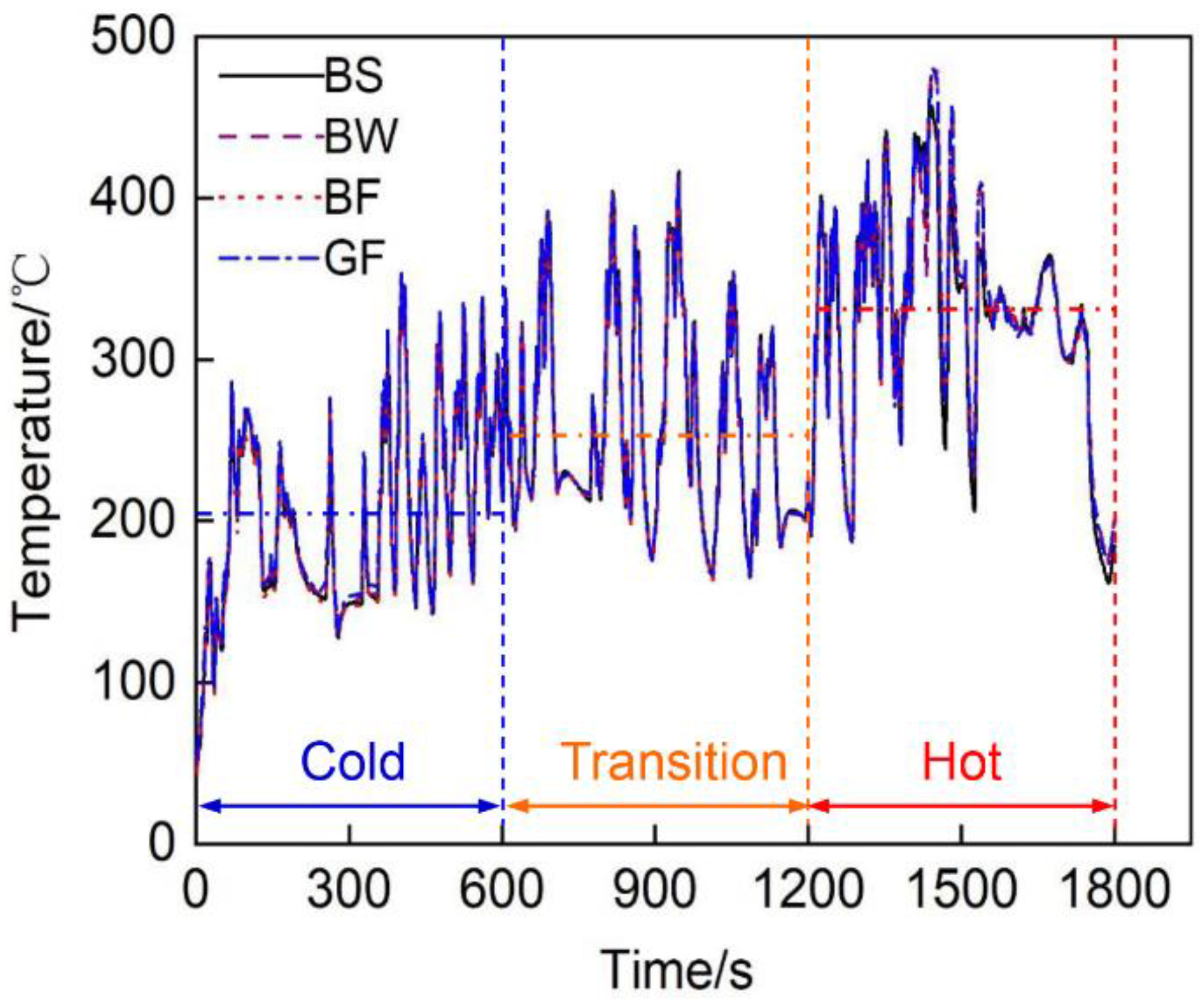

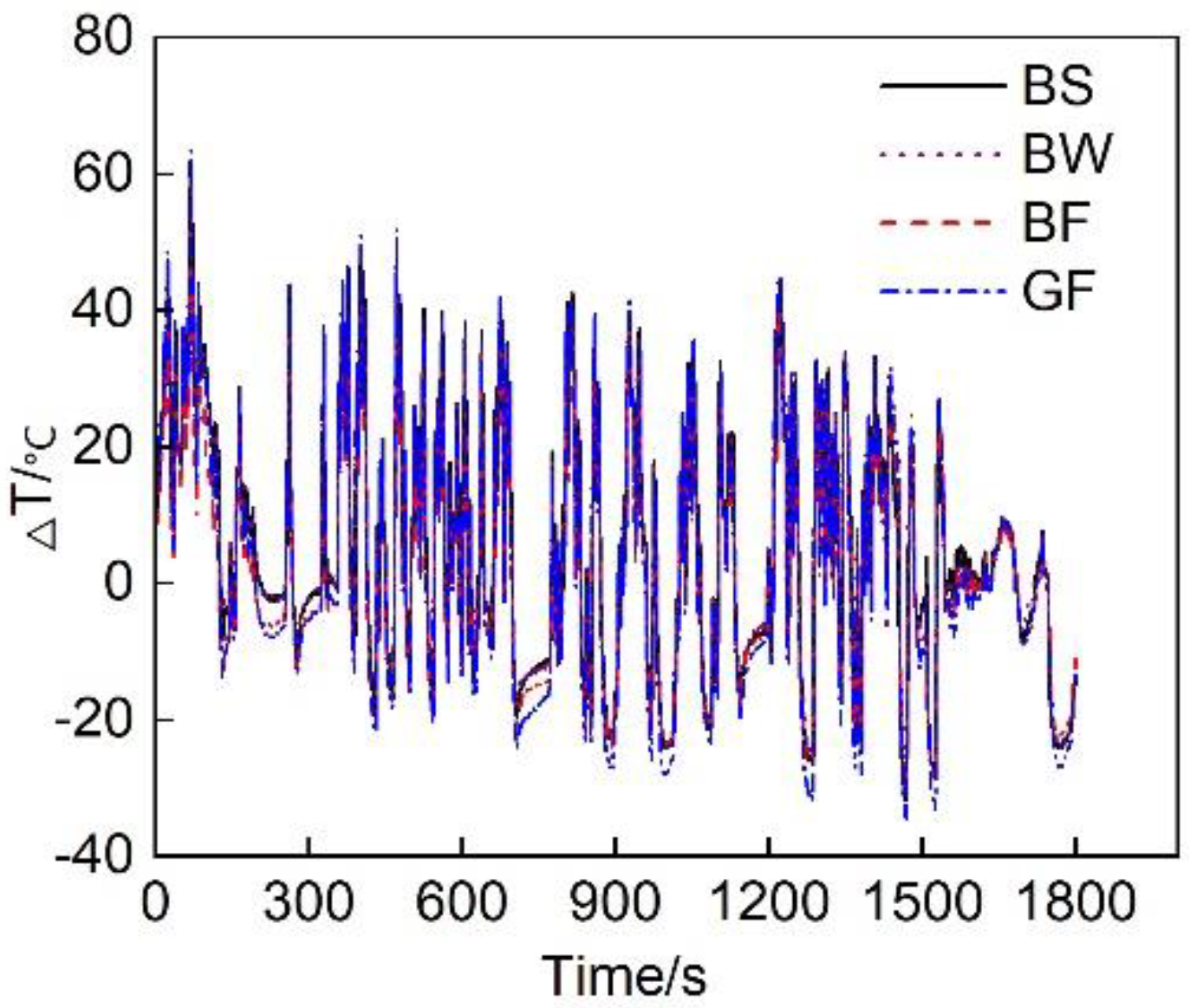


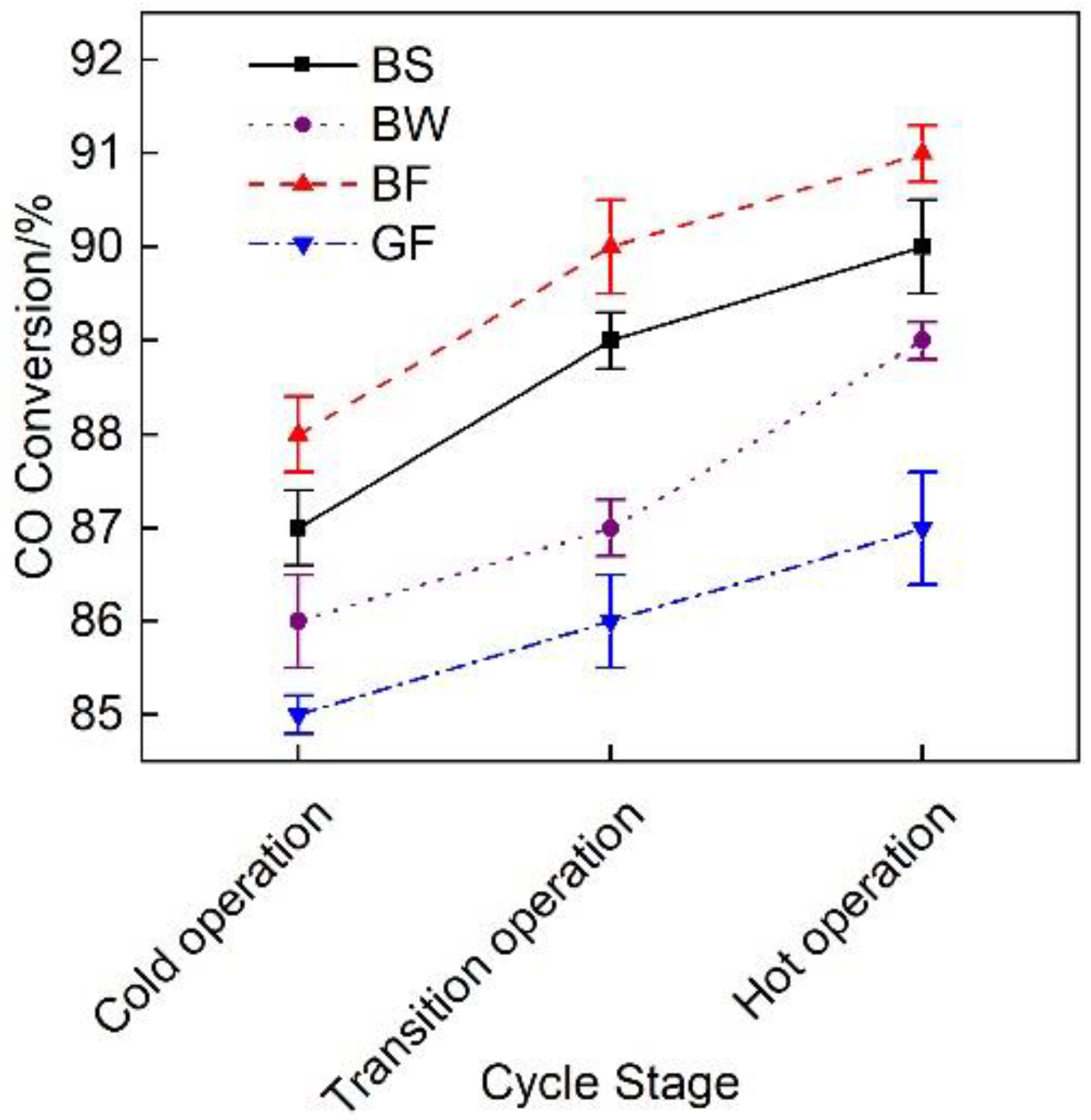
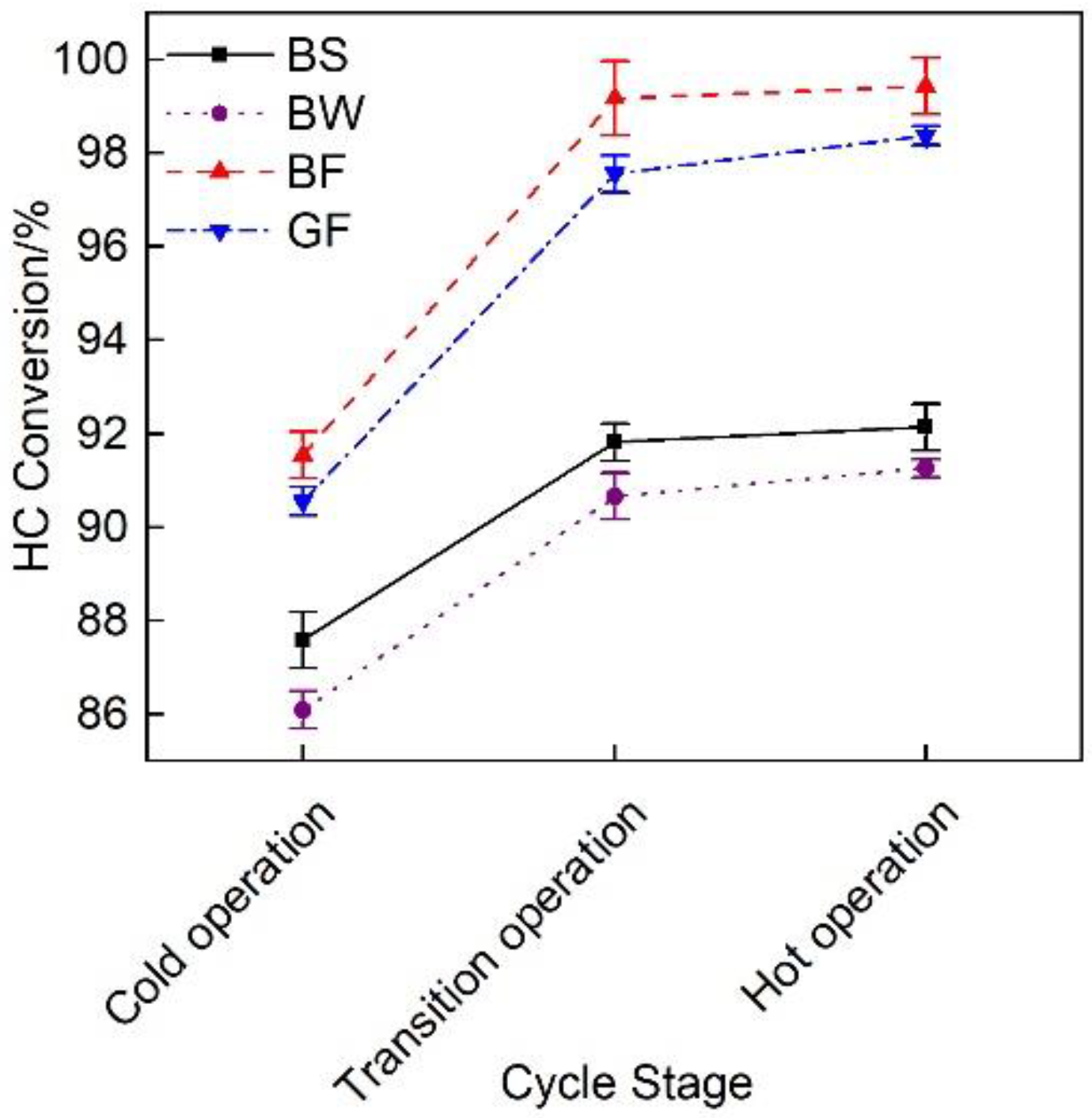
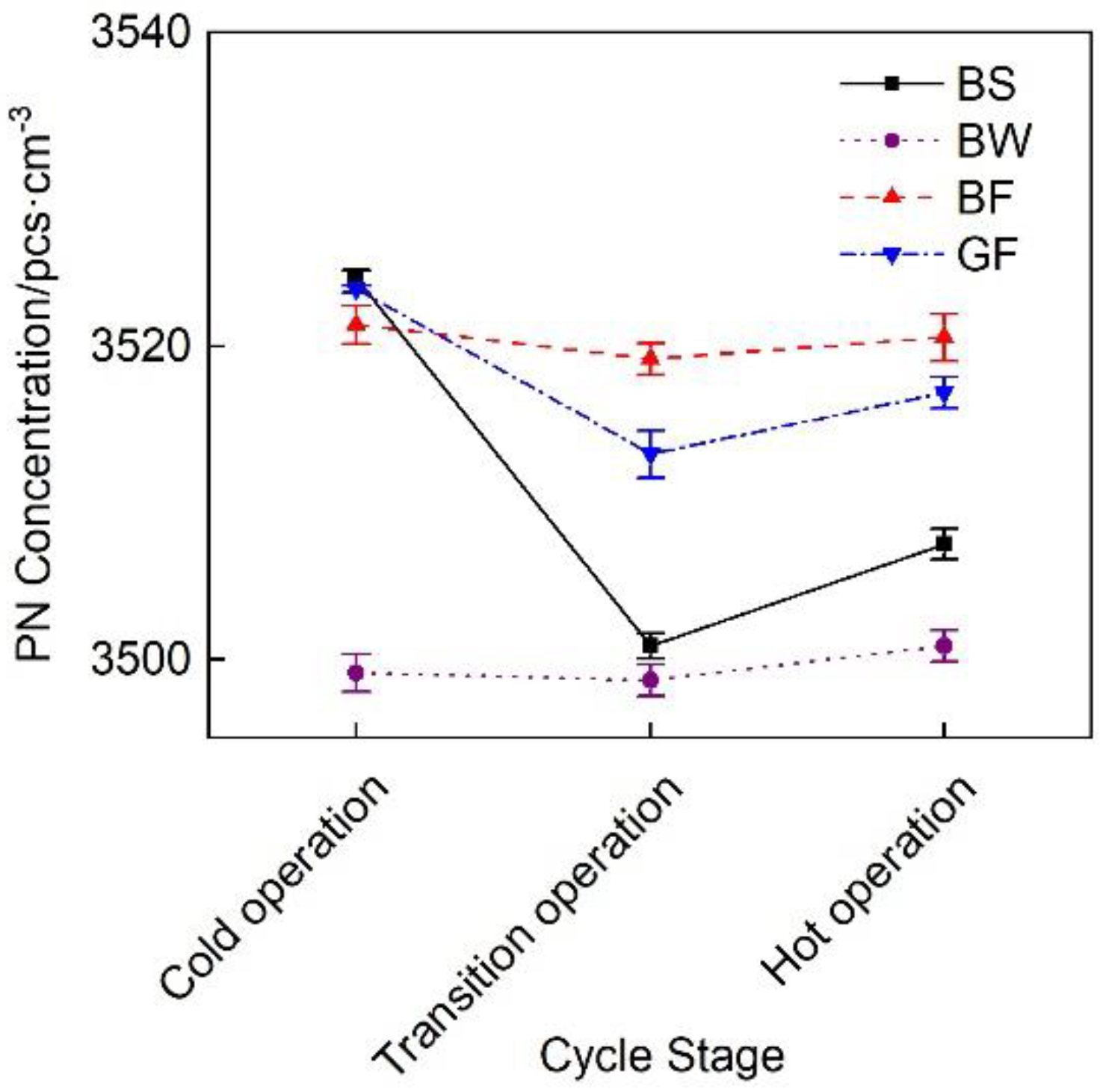

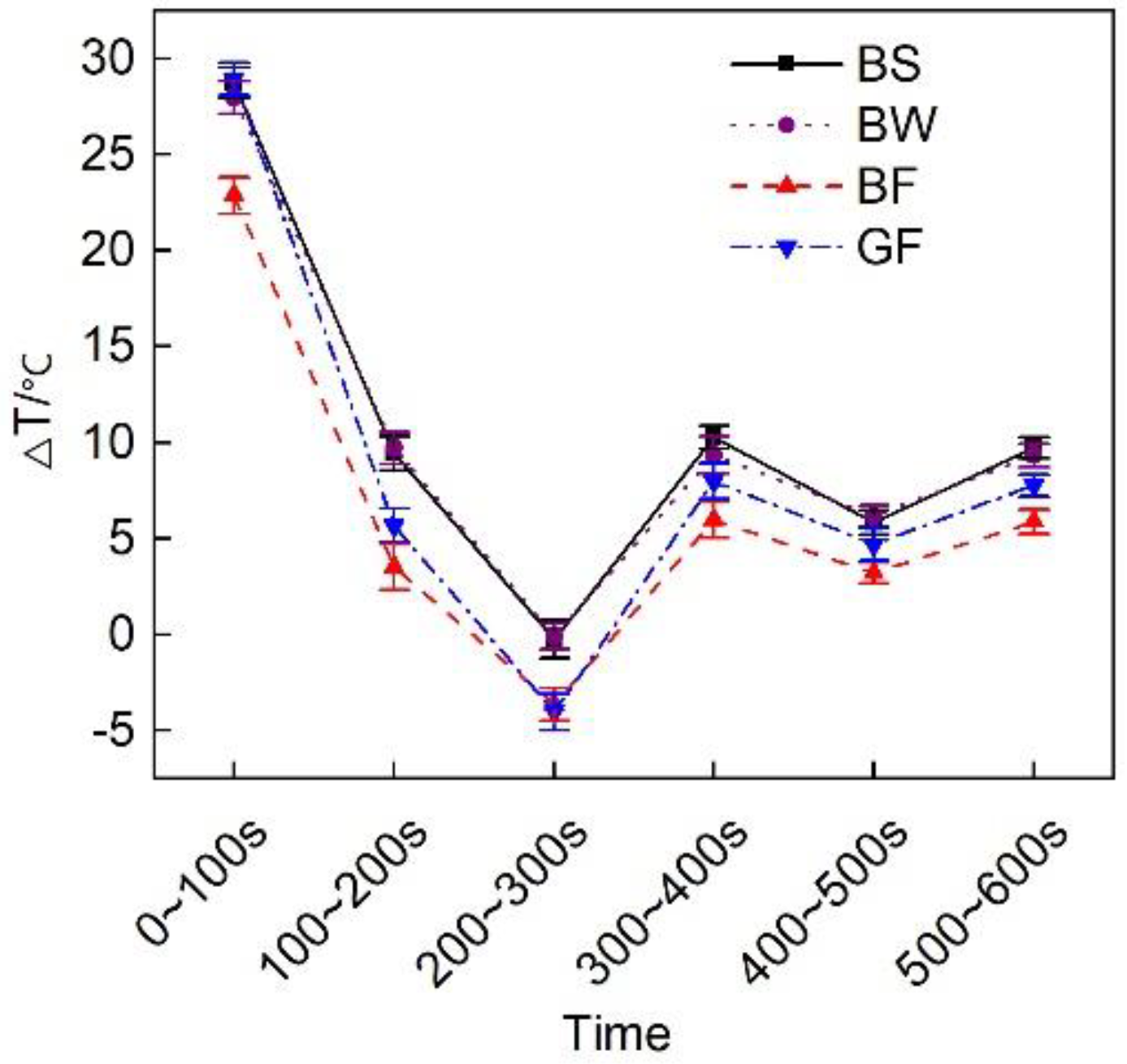
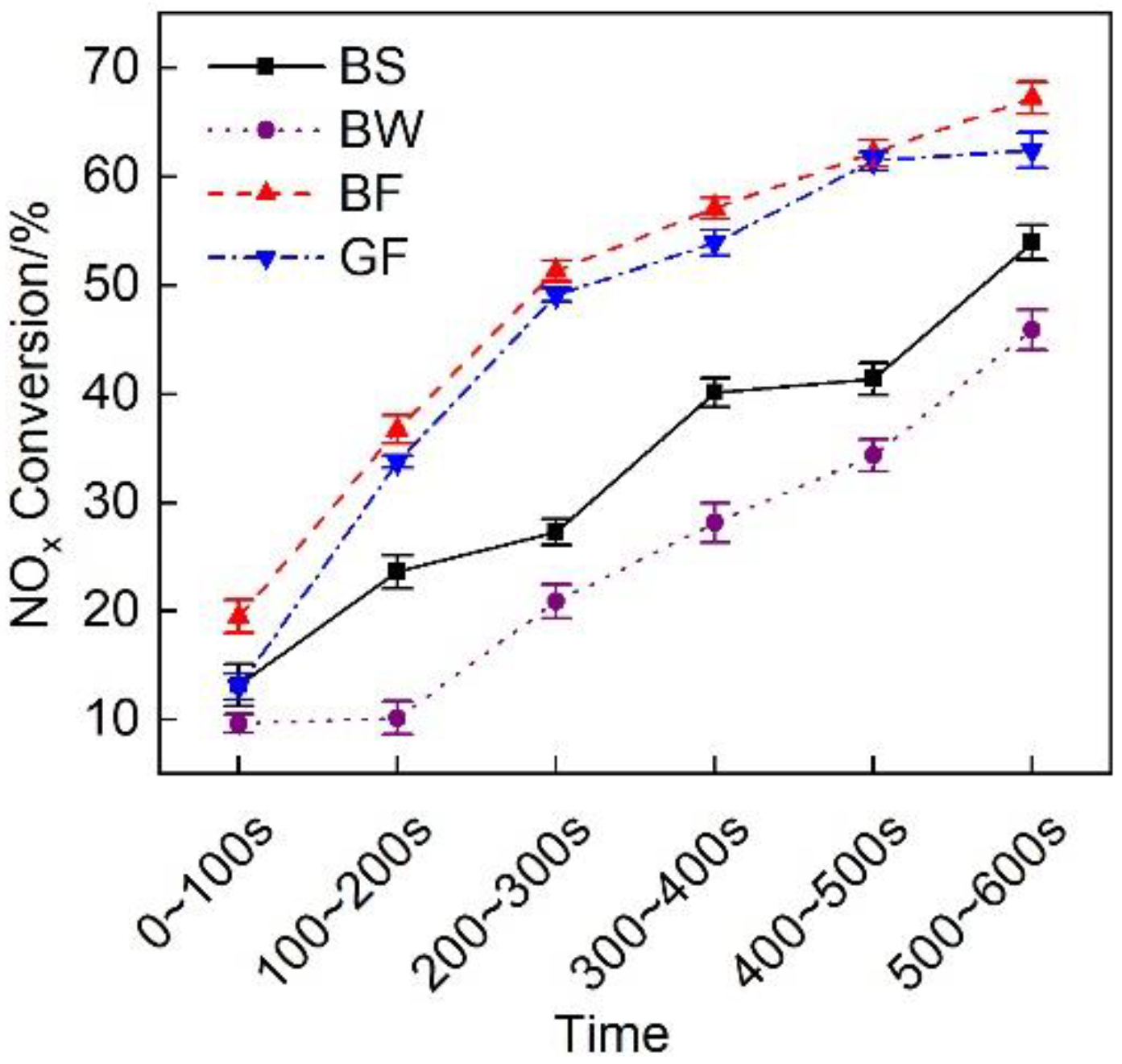
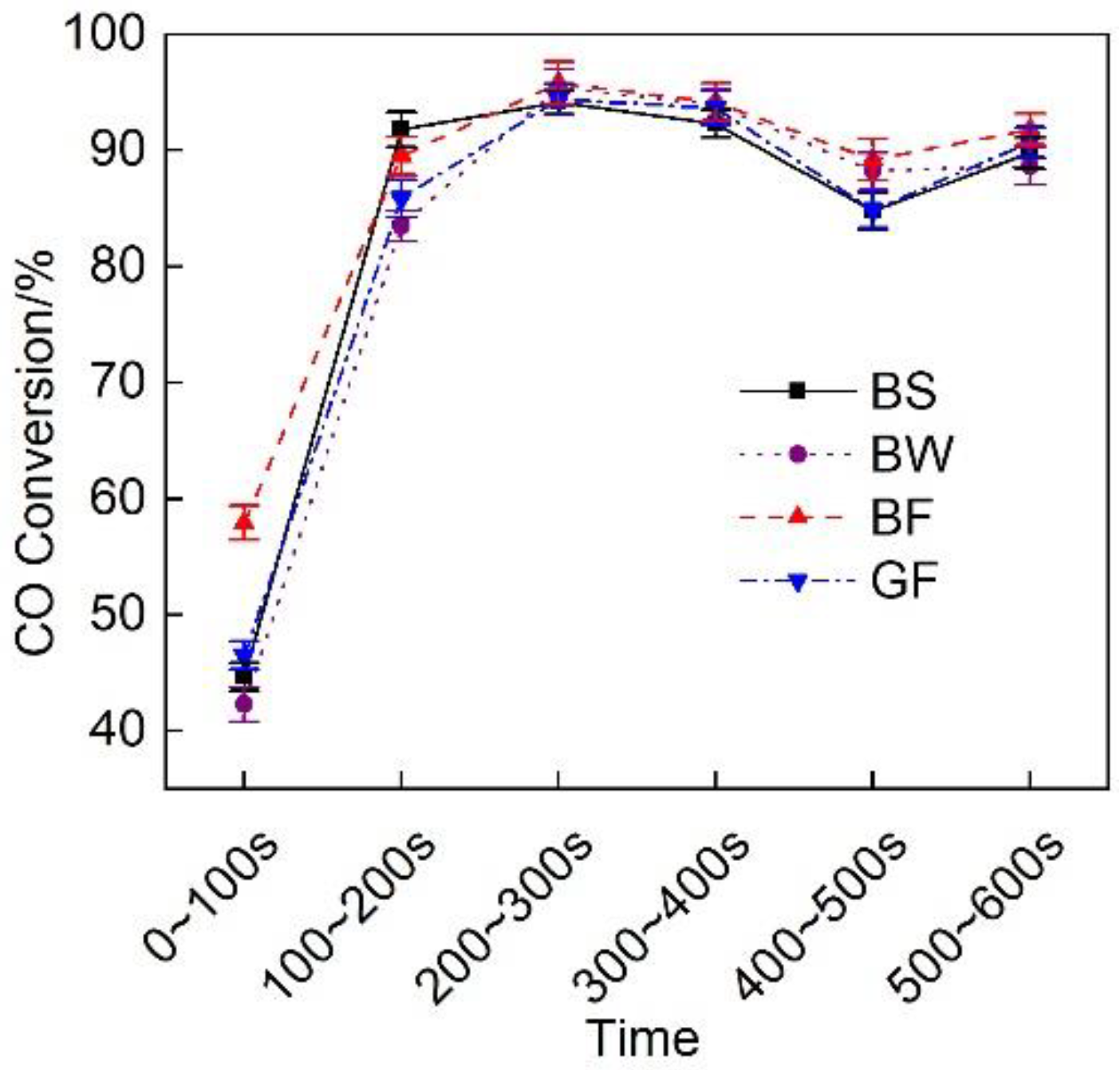
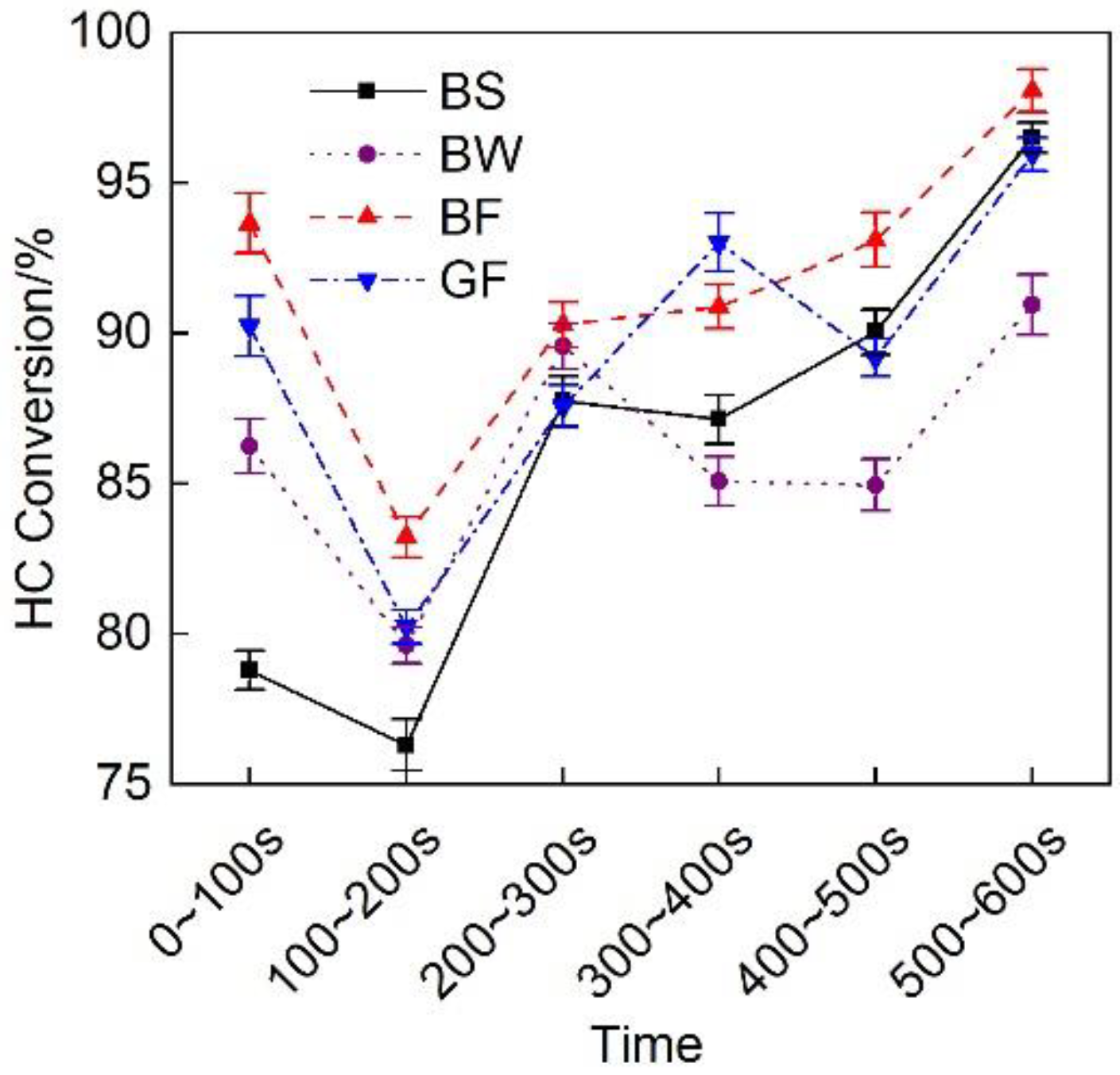
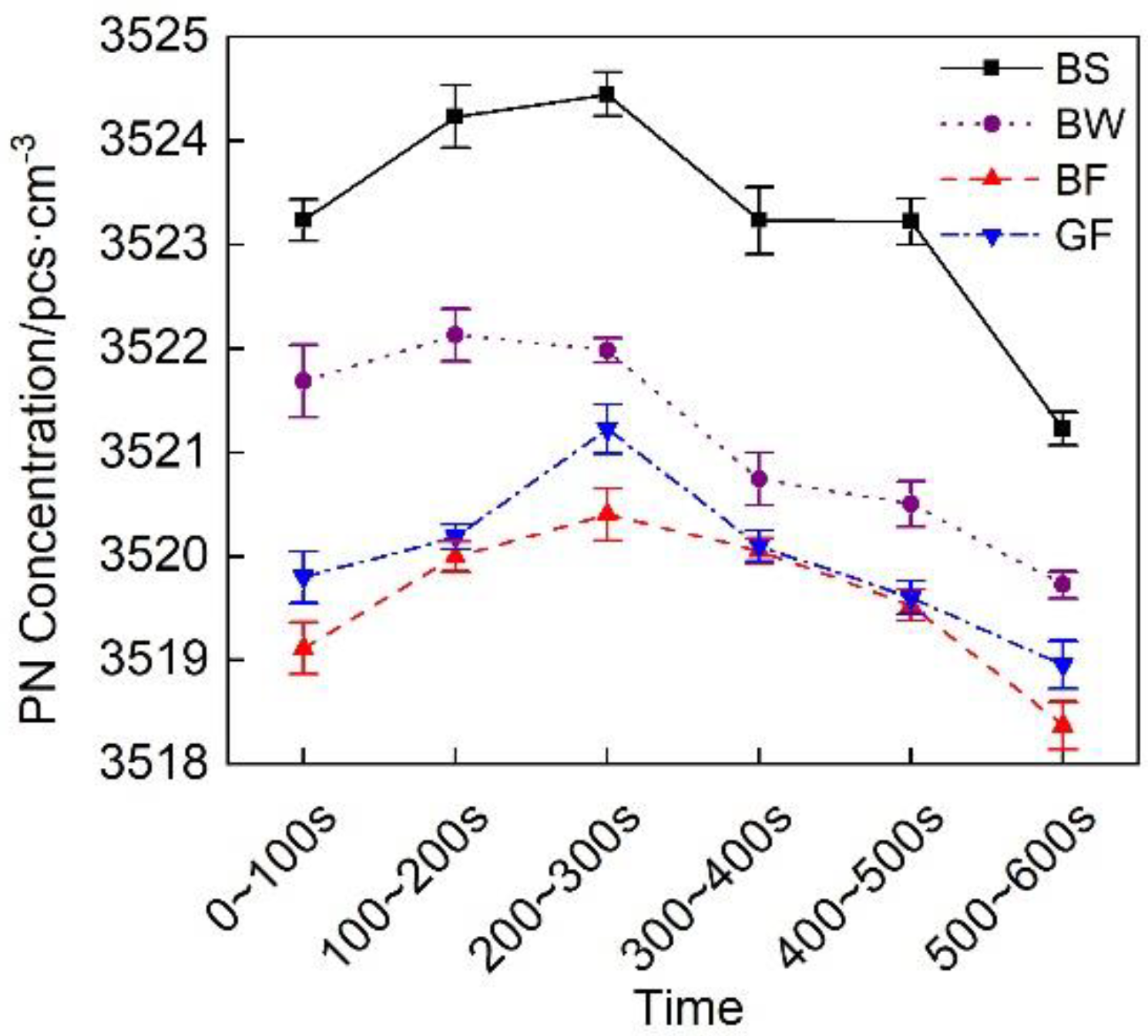
| Serial Number | Prototype | Thickness (mm) | Bulk Density (kg·m−3) | Thermal Conductivity (W/m∙k) | End-Use Temperature (°C) | Morphology |
|---|---|---|---|---|---|---|
| 1 | BS | 5 | 120 | 0.031 | 780 |  |
| 2 | BW | 5 | 120 | 0.031 | 780 |  |
| 3 | BF | 5 | 120 | 0.031 | 780 |  |
| 4 | GF | 5 | 120 | 0.049 | 400 |  |
| Project | Parameter |
|---|---|
| Diesel engine model | D45 |
| Displacement/L | 4.5 |
| Rated power/kW | 150 |
| Rated speed/r min−1 | 2300 |
| After-treatment device | DOC + SCR + DPF |
| Sample Item | Device Model | Sample Content |
|---|---|---|
| Gaseous substance | Horiba 7200D | NOx, CO, and hydrocarbons (HCs) |
| Number of particles (PN) | AVL489 | PN |
| Exhaust Gas Temperature | Emission Data | Test Cycle |
|---|---|---|
| 1. T1 before the pipe 2. T2 after the pipe | Gaseous substances: CO, HCs, and NOx Number of particles: PN | WHTC (cold state) |
Publisher’s Note: MDPI stays neutral with regard to jurisdictional claims in published maps and institutional affiliations. |
© 2021 by the authors. Licensee MDPI, Basel, Switzerland. This article is an open access article distributed under the terms and conditions of the Creative Commons Attribution (CC BY) license (https://creativecommons.org/licenses/by/4.0/).
Share and Cite
Zhao, K.; Lou, D.; Zhang, Y.; Fang, L.; Tang, Y. Experimental Study on Diesel Engine Emission Characteristics Based on Different Exhaust Pipe Coating Schemes. Micromachines 2021, 12, 1155. https://doi.org/10.3390/mi12101155
Zhao K, Lou D, Zhang Y, Fang L, Tang Y. Experimental Study on Diesel Engine Emission Characteristics Based on Different Exhaust Pipe Coating Schemes. Micromachines. 2021; 12(10):1155. https://doi.org/10.3390/mi12101155
Chicago/Turabian StyleZhao, Keqin, Diming Lou, Yunhua Zhang, Liang Fang, and Yuanzhi Tang. 2021. "Experimental Study on Diesel Engine Emission Characteristics Based on Different Exhaust Pipe Coating Schemes" Micromachines 12, no. 10: 1155. https://doi.org/10.3390/mi12101155







